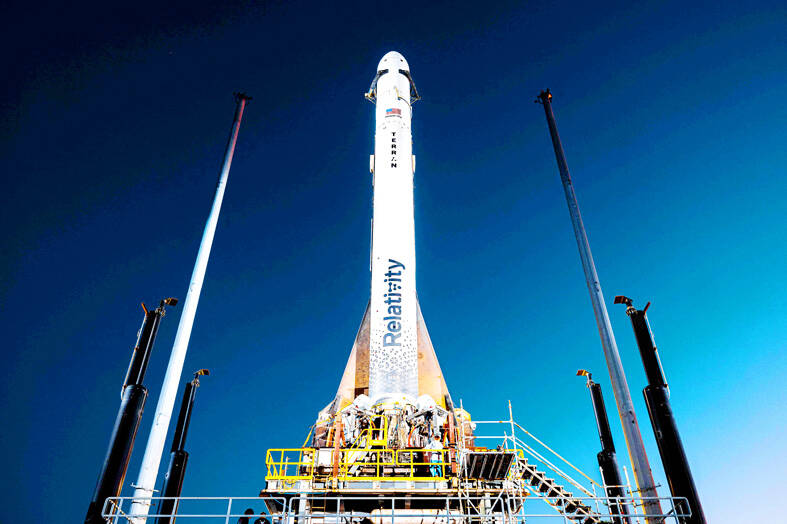The world’s first 3D printed rocket was yesterday scheduled to blast off from Florida on the maiden flight of an innovative spacecraft billed as being less costly to produce and fly.
Liftoff of the rocket, Terran 1, had been scheduled for Wednesday at Cape Canaveral, but was postponed at the last minute because of propellant temperature issues.
The new launch window for the rocket built by California aerospace start-up Relativity Space to put satellites into orbit was from 1pm to 4pm yesterday.

Photo: AFP / Trevor Mahlmann / Relativity Space
Terran 1 was set to reach low Earth orbit 8 minutes after blastoff on a voyage intended to gather data and demonstrate that it can withstand the rigors of liftoff and space flight.
If the rocket managed to attain low Earth orbit, it would be the first privately funded vehicle using methane fuel to do so on its first try, Relativity has said.
Terran 1 is not carrying a payload for its first flight, but the rocket would eventually be capable of putting up to 1,250kg into low Earth orbit.
The rocket is 33.5m tall with a diameter of 2.2m, and 85 percent of its mass is 3D printed with metal alloys, including the engines.
It is the largest ever 3D printed object according to the Long Beach-based company whose goal is to produce a rocket that is 95 percent 3D printed.
Terran 1 is powered by Aeon engines using liquid oxygen and liquid natural gas — the “propellants of the future,” Relativity has said.
Vulcan rockets being developed by United Launch Alliance and Space Exploration Technologies Corp (SpaceX) Starship use the same fuel, capable of eventually fueling a voyage to Mars.
Terran 1 has nine 3D printed Aeon 1 engines on its first stage and one 3D printed Aeon Vacuum engine on its second stage.
Relativity is also building a larger rocket, Terran R, capable of putting a payload of 20,000kg into low Earth orbit.
The first launch of a Terran R, which is designed to be fully reusable, is scheduled for next year from Cape Canaveral.
A satellite operator can wait for years for a spot on an Arianespace SA or SpaceX rocket, and Relativity Space hopes to accelerate the timeline with its 3D printed rockets.
“Long-term, a major benefit of 3D printing is the ability to more rapidly democratize space due to the incredible cost effectiveness, radical flexibility and customization,” the company said.
Relativity said its 3D printed rockets use 100 times fewer parts than a traditional rocket and a Terran 1 and a Terran R can be built from raw materials in 60 days.
Relativity has already signed commercial launch contracts worth US$1.65 billion, mostly for the Terran R, said CEO Tim Ellis, who cofounded the company in 2015.
“Medium-heavy lift is clearly where the biggest market opportunity is for the remaining decade, with a massive launch shortage in this payload class,” Ellis wrote on Twitter.

Hong Kong authorities ramped up sales of the local dollar as the greenback’s slide threatened the foreign-exchange peg. The Hong Kong Monetary Authority (HKMA) sold a record HK$60.5 billion (US$7.8 billion) of the city’s currency, according to an alert sent on its Bloomberg page yesterday in Asia, after it tested the upper end of its trading band. That added to the HK$56.1 billion of sales versus the greenback since Friday. The rapid intervention signals efforts from the city’s authorities to limit the local currency’s moves within its HK$7.75 to HK$7.85 per US dollar trading band. Heavy sales of the local dollar by

To many, Tatu City on the outskirts of Nairobi looks like a success. The first city entirely built by a private company to be operational in east Africa, with about 25,000 people living and working there, it accounts for about two-thirds of all foreign investment in Kenya. Its low-tax status has attracted more than 100 businesses including Heineken, coffee brand Dormans, and the biggest call-center and cold-chain transport firms in the region. However, to some local politicians, Tatu City has looked more like a target for extortion. A parade of governors have demanded land worth millions of dollars in exchange

Taiwan Semiconductor Manufacturing Co’s (TSMC, 台積電) revenue jumped 48 percent last month, underscoring how electronics firms scrambled to acquire essential components before global tariffs took effect. The main chipmaker for Apple Inc and Nvidia Corp reported monthly sales of NT$349.6 billion (US$11.6 billion). That compares with the average analysts’ estimate for a 38 percent rise in second-quarter revenue. US President Donald Trump’s trade war is prompting economists to retool GDP forecasts worldwide, casting doubt over the outlook for everything from iPhone demand to computing and datacenter construction. However, TSMC — a barometer for global tech spending given its central role in the

The Financial Supervisory Commission (FSC) yesterday met with some of the nation’s largest insurance companies as a skyrocketing New Taiwan dollar piles pressure on their hundreds of billions of dollars in US bond investments. The commission has asked some life insurance firms, among the biggest Asian holders of US debt, to discuss how the rapidly strengthening NT dollar has impacted their operations, people familiar with the matter said. The meeting took place as the NT dollar jumped as much as 5 percent yesterday, its biggest intraday gain in more than three decades. The local currency surged as exporters rushed to